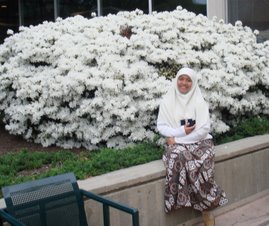This is my response towards my friend’s Priya report on article:
http://www.techlearning.com/story/showArticle.php?articleID=60300276.html
When I read this article, I found it interesting and insightful for teachers. Digital stories can help broaden students knowledge on people personal stories and can help them start writing their own stories. Digital stories in my country, it can fit into several subjects and can be an integrated and interdisciplinary project. It can be a IT project, English, Bahasa Indonesia (our language) or even to social sciences when the stories tell about a country hero. My friend Priya then asked,
“How can digital stories fit into Math and science? I think it is more apt for the humanities and the arts.”
Well, like it is supposed to be, digital stories meant to be a storytelling in a digital form. Stories, yes I agree, is more to a humanities related text. But it can not be denied that there is a possibility to make stories for math and Science content. As you know, our Digital Native (Marc Prensky,2001) learn Math by Sesame Street and Barney. They learn Physics and Biology through games and software. So it is also possible to learn Science and Math through Digital Stories.
Some of us probably have or once had online course in the university. There, even lecturer or our professor explained the lessons and content material using voiced powerpoint or camtasia. Even when we learn difficult materials or lessons such as Math or Quantitative research (at least it’s hard for me), we could learn it digitally.
So again, for me, we can make digital stories for those two subjects as long as we shape and pack it in appropriate way. I remember a flash game about probability. There was a family of five trapped in an uninhabited Island need to be saved from a giant dragon. There’s only one almost sinking boat to save them with three holes and with capacity of two people (three with the boatman) and can only come to the island twice. How can we save the family? Here, we can see math problem, with a story and need solution. If we create and develop a story, it can now become a digital story, isn’t it?
The next question she asked was : ”What rubrics can be developed if it is used as a tool for assessment?”
For me, rubrics are made according to the objectives we would like to have for every specific lesson. Then, the rubrics may vary from one to another. If we are teaching English then our rubrics will be more to the language process, the content of the story, or and the grammar and pronunciation of the story-teller. If it is integrated to IT, then we can add the techniques and output result in the stories produced become a consideration. If it is integrated with other subject then the content matters should be evaluated. One thing that I mark from Understanding by Multimedia Design project that objectives is the most important thing we should set up before we decide what kind of rubrics we design.
How can one fit it into the school timetable, as it might involve a lot of time?
That is the next question she asked. I simply answered it depends on time allocation of each school. If we have a limited time, then it can be more on individual or group project done outside the class. In the class, we can only give the guidelines, show them how to do that, and ask for progress each session until the deadline. We can divide some steps of making the stories into several progress report, so whenever we have sessions, they can give new progress they made.
Her last question:
And finally, how can we learn to do this? Is there an online tutorial?
I think we can use voice powerpoint or camtasia and produce it as podcast or vodcast(videopodcast) or in avi file. We can practice it before we teach the students and produce a sample one. In the article it is written a brief tutorial on how we can make this.
Some podcast in the internet that I download shows simple stories, legends and fables that can be our ideas before creating it.
In short, for there is nothing impossible for learning things. There is only long time and short time in learning. The same thing learned can be short time to learn for someone and long time for others. As a saying: Practice makes perfect. We can learn anything if we open our mind , try to do it, and say to ourselves : We can do it, we should be able to it, and we will be able to do it. (this saying is a motivation that I always say to myself and to my students whenever learning something new).
Does anyone has a better solution on how to Digital Stories?
Subscribe to:
Post Comments (Atom)


No comments:
Post a Comment